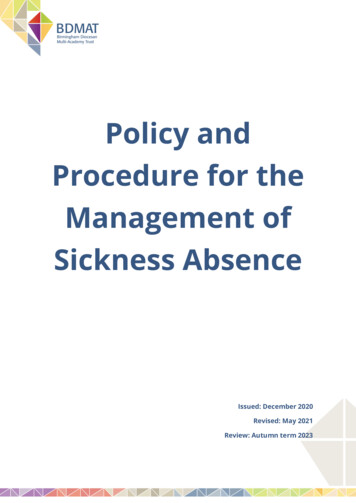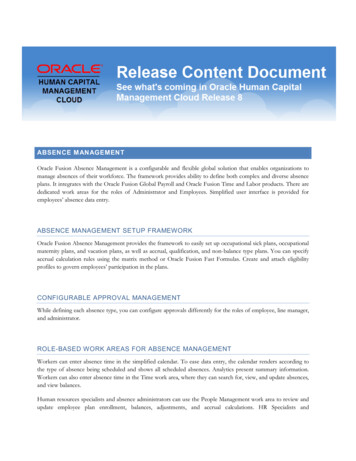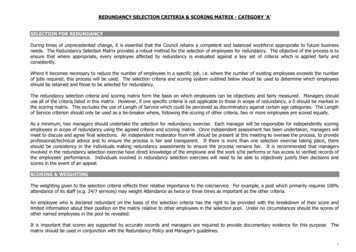
Transcription
NEW VeriSafe Absence Of Voltage Tester–Improving Efficiency andReducing CostNew Technology For The Factory FloorThat Automates Absence Of Voltage TestingReducing Time, Complexity, And Costs
More Meaningful ConnectionsWhen servicing electrical equipment, workers must complywith safety regulations that require a voltage verificationtest to validate the absence of voltage. This process requiresstrict adherence to prevent accidents and bodily injury,but includes many stages that can be complex and timeconsuming when using hand-held portable test instruments.This paper examines the costs and limitations involved withusing a manual absence of voltage tester. It also describesa new technology for the factory floor that automates theprocess, reducing time, complexity, and costs.2VeriSafe Absence of Voltage Tester–Improving Efficiency and Reducing Costs WHITE PAPER
More Meaningful ConnectionsHistorical Costs of Checking forAbsence of VoltageNumerous studies exist pertaining to injuries resulting from electricshock and arc flash events. These studies recognize that establishingthe economic payoffs of prevention is a critical factor in promotingworkplace safety. Besides personal injury, the costs of property andequipment damage need to be considered. Although estimates vary,studies have shown that the average direct cost of an electrical injuryranges from about US 50,000 to US 80,0001, while the indirect costcan exceed the direct cost by a factor of nearly four2. Direct costs includelost wages or workers’ compensation payments, medical expenditures,and legal expenses. Indirect costs include: wages paid during work stoppage administrative costs related to injury property damage and repair training and compensation for replacement workers lost productivity with less experienced workers fines related to workplace safety violations potential increase in absenteeism decrease in moraleElectrical injuries have one of the highest average workers’ compensationcosts, second only to motor vehicle accidents3.3VeriSafe Absence of Voltage Tester–Improving Efficiency and Reducing Costs WHITE PAPERInjuries from contact withexposed wiring, transformers,or other electricalcomponents frequently occurin the workplace and involveconstruction, installation,maintenance, and repairworkers. These injuries areoften costly and serious, asdemonstrated by the numberof days away from work; 51%of workers missed over oneweek of work due to theseinjuries, with 40% missingtwo weeks or more4,5.
More Meaningful ConnectionsLimitations of Using a Handheld TesterVerifying the absence of voltage is part of the process to establish anelectrically safe work condition. Step 5 of NFPA 70E-2015 Article 120.56describes this process:Use an adequately rated test instrument to test each phase conductoror circuit part to verify it is de-energized. Test each phase conductor orcircuit part both phase-to-phase and phase-to-ground. Before and aftereach test, determine that the test instrument is operating satisfactorilythrough verification on a known voltage source.This process usually involves a portable, handheld voltage test instrument.To be effective, it is critical to perform each step of the process insequence, and it requires taking the necessary precautions, such as theproper use of personal protective equipment (PPE) (Figure 1).ComplexityAdhering to this process prevents electrical injuries, but the process iscomplex and time consuming. Portable instruments are susceptible tomechanical and electrical failure and misuse by the person using thedevice. In addition, because the process of using a handheld tester isdependent on human input, interaction, and interpretation, it is vulnerableto mistakes and errors.Figure 1. Absence of voltage test using ahandheld voltage test instrument.Training CostsTraining on the selection, maintenance, and use of test instrumentsis crucial as are systems for inspecting and maintaining voltage testinstruments. However, training and maintaining the test equipmentincur the additional expenses of time and cost.Safety Is In Your Hands:The Risks of VoltageTesting18.3%36.7%Facilities experienced aReported near missespersonal injury whenof personal injuryusing hand-held voltagetest instruments411.7%Facilities experiencedinterruptions to plantoperations due tovoltage testing incidentsVeriSafe Absence of Voltage Tester–Improving Efficiency and Reducing Costs WHITE PAPERH. L. Floyd and B. J. Nenninger, “Personnel Safety and Plant ReliabilityConsiderations in the Selection and Use of Voltage Test Instruments,” IEEETransactions on Industry Applications, vol. 33, no. 2, pp. 367-373, 1997.
More Meaningful ConnectionsElectrical SafetyRisky Business: Potential ElectricalHazards Exist When PerformingAbsence of Voltage TestingTesrTestehettTRADITIONALMETHODrtehand-held testers withthe risk of exposure toelectrical hazardsEven when hazards are part of the everyday routine, deviations from asafety procedure can slowly become accepted practice. These deviationsare particularly evident when there are time pressures, which is oftenthe case when electrical maintenance causes unplanned or excessivedowntime. If either training or enforcement of administrative proceduresis lacking, the effectiveness of the procedures will diminish.5VeriSafe Absence of Voltage Tester–Improving Efficiency and Reducing Costs WHITE PAPERReTest theTesWhen processes are overly complex or time-consuming, workers tend tobecome complacent and develop shortcuts as practices become routine.A normalization of deviance—small, gradual deviations from an establishedpractice—may occur over time. With the lack of negative consequences,the lower standard eventually becomes the norm7,8.ck the VoltagCheeA disadvantage of implementing a voltage verification test with ahandheld tester is that the person performing it may be exposed toelectrical hazards while verifying that the tester is working prior to andafter the test, and during the test if the equipment was not de-energized.With such a significant emphasis on performing work only onde-energized equipment, it is ironic that best practice relies on PPE andexposure to hazards before de-energized work begins. The need for PPEis a significant contributor to the overall time to carry out this processbecause the worker must first determine the required PPE, then obtain,inspect, dress, and properly store it after use. Additionally, PPE can bemisused or not used at all, especially when there are time constraints.
More Meaningful ConnectionsA More Efficient Way to Test for Voltage–VeriSafe Absence of Voltage TesterMinimize Your Risk: VeriSafe AVTVerifies Absence of VoltageBefore Equipment is AccessedTesterheationt t InstallifyVERISAFETM Tests phase-to-phase and phase-to-groundautomaticallyperformed insequence Supports compliance with NFPA 70E-2018 Article 120.5 Rated safety integrity level (SIL) 3 per IEC 61508The VeriSafe AVT is applicable for several applications: Equipment with a single source of incoming power High risk associated with access Equipment with high incident energy Remote or difficult to access locations – Outdoor, mezzanine, catwalk Sites with temporary or intermittent power Equipment with stored electrical energy – VFDs, capacitors, etc. Equipment frequently serviced by third-party technicians or contractorsFigure 2. VeriSafe Absence of Voltage Tester.6VeriSafe Absence of Voltage Tester–Improving Efficiency and Reducing Costs WHITE PAPERrteVerify In thesta Tellat s Active indication for absence of voltagenio Automated test sequenceck the VoltagChee Built-in pre-/post-verification testT Self-contained; no additional meters or tools are neededeVe sr Tests without exposure to harmful voltages/currentsRe-TestThe VeriSafe Absence of Voltage Tester (AVT) automates the voltageverification process and is the first AVT tailored for electrical enclosures(Figure 2). By automating this process, the VeriSafe Absence of VoltageTester features the following:
More Meaningful ConnectionsNFPA 70EOne of the major changes to the 2018 edition of NFPA 70E involves the new requirements that allowan installed AVT to be used instead of a handheld voltage tester. When the VeriSafe AVT is used inconjunction with a Lockout/Tagout Program, it meets the requirements for the process described inNFPA 70E-2018 Article 120.5:Exception No. 1: An adequately rated permanently mounted test device shall be permitted to be usedto verify the absence of voltage of the conductors or circuit parts at the work location, provided itmeets the following requirements:a) It is permanently mounted and installed in accordance with the manufacturer’s instructions andtests the conductors and circuit parts at the point of workb) It is listed and labeled to verify the absence of voltage9c) It tests each phase conductor or circuit part both phase-to-phase and phase-to-groundd) The test device is verified as operating satisfactorily on any known voltage source before and afterverifying the absence of voltagePortable TestersFigure 3. Comparison of the VeriSafe absence of voltage tester and portable device testing testtheTesterPerformWorkVeriSafe Absence ofVoltage TesterPossible Exposure to Electrical HazardsActivate the VeriSafe Absence of Voltage geVerifyInstallationAutomatically Performed in SequenceNo Exposure to Electrical Hazards7VeriSafe Absence of Voltage Tester–Improving Efficiency and Reducing Costs WHITE PAPERRetesttheTesterOpenPanel
More Meaningful ConnectionsConclusionIntegrating the VeriSafe Absence of Voltage Tester is a vital improvementto absence of voltage testing. A solid testing method helps create areliable, safe, cost effective system that workers can use as needed. TheVeriSafe Absence of Voltage Tester verifies the absence of voltage beforeequipment is accessed, making it easier for qualified electrical workersto determine an electrically safe environment in a fraction of the timerequired by hand-held portable test instruments.am Power: OstreNUpWhen no voltage is detected,indicators are not illuminatedThis does not guarantee theabsence of voltage.URED indicates hazardous ACvoltage is present.pst re aOFm P o w e r:GREEN indicates theabsence of voltage isverified.am Power: OFFstreUpUFYELLOW caution indicatorflashes when the test button ispressed and the test is initiated.pst re a:m Po w erOFFR. B. Campbell and D. A. Dini, Occupational Injuries from Electrical Shock and Arc Flash Events. Quincy, MA: Fire Protection Research Foundation, 2015.F. A. Manuele, “Accident costs: Rethinking ratios of indirect to direct costs,” Prof. Safety, pp. 39–47, Jan. 2011.I. B. Horwitz and B. P. McCall, “An epidemiological and risk analysis of Virginia workers’ compensation burn claims 1999 to 2002: Identifying and prioritizing preventative workplace interventions,”J. Occup. Environ. Med., vol. 49, no. 12, pp. 1376–1385, 2007.4Bureau of Labor Statistics. Injuries, illnesses, and fatalities. [Online]. Available: http://www.bls.gov/iif/data.htm5U.S. Department of Labor. Bureau of Labor Statistics census of fatal occupational injuries. [Online]. Available: http://www.bls.gov/iif/oshcfoi1 .htm6Standard for Electrical Safety in the Workplace 2015 Edition, NFPA 70E, 2015.7A. Johnson. (2011, Nov. 1). Not an easy task. Safety Health. [Online]. Available: t-an-easytask-28J. Wettstein. (2013, Oct. 24). When safety shortcuts become the norm. [Online]. Available: ome-the-norm/9Only 0AVTs listed to UL 1436 as an AVT meet this requirement.1238VeriSafe Absence of Voltage Tester–Improving Efficiency and Reducing Costs WHITE PAPER
Since 1955, Panduit’s culture of curiosity and passion for problem solving have enabled more meaningful connections between companies’business goals and their marketplace success. Panduit creates leading-edge physical, electrical, and network infrastructure solutions forenterprise-wide environments, from the data center to the telecom room, from the desktop to the plant floor. Headquartered inTinley Park, IL, USA and operating in 112 global locations, Panduit’s proven reputation for quality and technology leadership,coupled with a robust partner ecosystem, help support, sustain, and empower business growth in a connected world.THE INFORMATION CONTAINED IN THIS WHITE PAPER IS INTENDED AS A GUIDE FOR USE BY PERSONS HAVING TECHNICAL SKILL AT THEIR OWN DISCRETION AND RISK. BEFORE USING ANYPANDUIT PRODUCT, THE BUYER MUST DETERMINE THE SUITABILITY OF THE PRODUCT FOR HIS/HER INTENDED USE AND BUYER ASSUMES ALL RISK AND LIABILITY WHATSOEVER IN CONNECTIONTHEREWITH. PANDUIT DISCLAIMS ANDY LIABILITY ARISING FROM ANY INFORMATION CONTAINED HEREIN OR FOR ABSENCE OF THE SAME.All Panduit products are subject to the terms, conditions and limitation of its then current Limited Product Warranty, which can be found at www.panduit.com/warranty.PANDUIT US/CANADAPANDUIT EUROPE LTD.London, UKPANDUIT SINGAPORE PTE. LTD.Republic of SingaporePANDUIT JAPANTokyo, Japancs-japan@panduit.comPANDUIT LATIN AMERICAGuadalajara, MexicoPANDUIT AUSTRALIA PTY. LTD.Victoria, Australia 2017 Panduit Corp. ALL RIGHTS RESERVED. SFAT03--SA-ENG 9/2017
Step 5 of NFPA 70E-2015 Article 120.56 describes this process: Use an adequately rated test instrument to test each phase conductor . Training on the selection, maintenance, and use of test instruments is crucial as are systems for inspecting and maintaining voltage test










